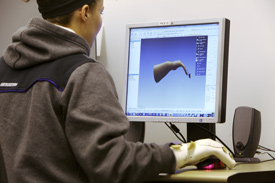3-D Printing in Action: Senior Builds Better Hand Splint
Softball player puts mechanical engineering knowledge to use on broken finger
Lauren Tyndall was diving into third base during a pre-season practice session when it happened.
“The girl at the base swept it with her glove, and it broke my right pinkie just above the knuckle,” said Tyndall (’13), an outfielder on Northwestern’s girls’ softball team.
As if missing out on softball wasn’t bad enough, Tyndall had another annoyance: an uncomfortable, hot, itchy hand splint. Most students might have to grin and bear six weeks of discomfort — but Tyndall, a combined studies (mechanical engineering design) major at the McCormick School of Engineering, had the skills to take matters into her own hands.
 After getting her doctor’s permission, Tyndall first attempted to modify the boilerplate splint by drilling holes in it for cooling and pairing it with a fabric glove for softness.
After getting her doctor’s permission, Tyndall first attempted to modify the boilerplate splint by drilling holes in it for cooling and pairing it with a fabric glove for softness.
But it still wasn’t good enough, so she headed to McCormick’s 3-D Prototyping Lab. Located in the Ford Motor Company Engineering Design Center, the lab offers undergraduate and graduate students access to cutting-edge equipment like the 3D Systems Z450, a machine that creates shapes by depositing thousands of 0.1-millimeter-thick layers on top of one another until objects take shape. Other offerings — generously donated by the late McCormick alumnus James Farley (’50)— include stereolithography equipment, a waterjet cutting center, and soon, a metal selective laser sintering system.
Tyndall scanned an image of her hand into one of the lab’s computers, and using the Rapidform program, designed a 3-D splint that would perfectly cradle her hand. Because the Z450 can print in a variety of materials ranging in softness from stiff to rubber-like, she designed the splint with a hard exterior and a soft inner cushion.
It fit perfectly. In a second iteration, she used the 3D printed piece as a mold and crafted a thermoplastic splint with a layer of foamy neoprene for added cushion. With that, she had a winner.
“Finally, I could sleep, work, and type on computers,” Tyndall said.
After graduating last month, Tyndall is spending the summer using her engineering skills for Northwestern’s athletics department, where she is designing custom devices to meet student athletes’ needs. Projects include a device to prevent pitchers’ shoes from being damaged and modified softball gear that is easier to travel with.